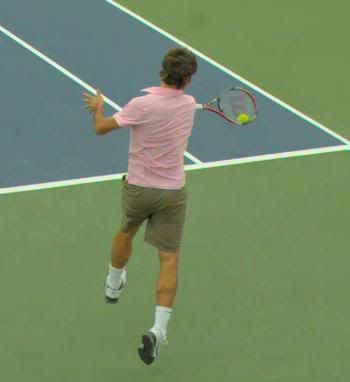JohnYandell
Hall of Fame
Guys,
So here is the long promised Federer high speed forehand at 500 frames/sec shot not in practice but a live match this past summer in Cincy.
http://www.tennisplayer.net/public/tw/fed/
This rear view clarifies a few things about preparation, extension, racket face angle and swing path.
First watch how the preparation actually starts before he even lands the split step. The right outside foot is starting to turn.
You do not wait to start the preparation. It begins with the feet and torso. In less than 2/10s of a second after that right foot lands, the shoulders have turned essentially 90 degrees. This is called the unit turn. The hands arms and racket naturally turn as well as a consequence of this unitary body motion.
At this point the hands and the arms start to move independently, going upward and backward together with both hands still on the racket. This is the start of the backswing in my view because the hands and arms are moving on their own not just as a function of the turn.
This takes less than another 2/10s of a second. Now the hands start to separate. The racket hand goes up probably a bit further and then starts down. The left arm straightens out and stretches across the body, eventually pointing directly at the sideline.
Look at how all this happens before the ball bounce on the court. The backswing does not start at the bounce of the ball. The turn is complete at around the bounce. This full turn position and the timing of it is characteristic of virtually every player in the pro game. Notice also that the preparation motion is completely smooth and continuous. It never stops. There is no pause.
Occassionally on a very slow ball or a let cord the players will pause and that is porbably 2% of the thousands of forehands I've filmed. Rhythm comes from this immediate smooth continuous preparation.
So here is the long promised Federer high speed forehand at 500 frames/sec shot not in practice but a live match this past summer in Cincy.
http://www.tennisplayer.net/public/tw/fed/
This rear view clarifies a few things about preparation, extension, racket face angle and swing path.
First watch how the preparation actually starts before he even lands the split step. The right outside foot is starting to turn.
You do not wait to start the preparation. It begins with the feet and torso. In less than 2/10s of a second after that right foot lands, the shoulders have turned essentially 90 degrees. This is called the unit turn. The hands arms and racket naturally turn as well as a consequence of this unitary body motion.
At this point the hands and the arms start to move independently, going upward and backward together with both hands still on the racket. This is the start of the backswing in my view because the hands and arms are moving on their own not just as a function of the turn.
This takes less than another 2/10s of a second. Now the hands start to separate. The racket hand goes up probably a bit further and then starts down. The left arm straightens out and stretches across the body, eventually pointing directly at the sideline.
Look at how all this happens before the ball bounce on the court. The backswing does not start at the bounce of the ball. The turn is complete at around the bounce. This full turn position and the timing of it is characteristic of virtually every player in the pro game. Notice also that the preparation motion is completely smooth and continuous. It never stops. There is no pause.
Occassionally on a very slow ball or a let cord the players will pause and that is porbably 2% of the thousands of forehands I've filmed. Rhythm comes from this immediate smooth continuous preparation.
Last edited:





